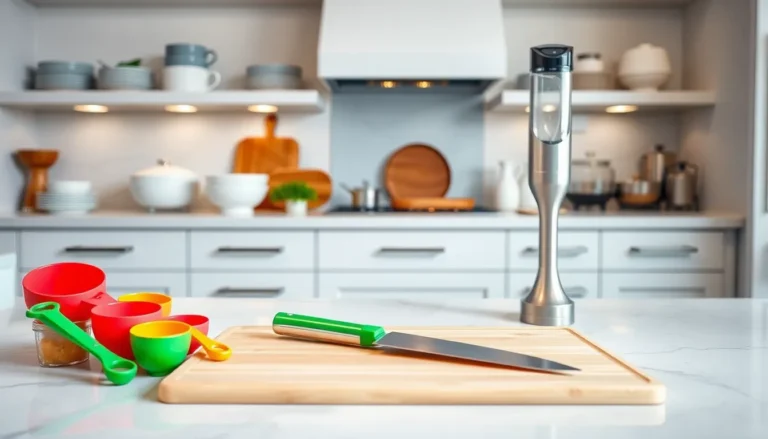Tired of flickering lights and outlets that seem to have a mind of their own? It’s time to roll up those sleeves and dive into the electrifying world of DIY electrical projects. Whether you’re a seasoned pro or just someone who thinks a circuit is something you run on a treadmill, there’s a project waiting for you.
Table of Contents
ToggleOverview of DIY Electrical Projects
DIY electrical projects provide an opportunity to enhance skills and improve living spaces. Various tasks, such as installing light fixtures or replacing outlets, contribute to home safety and functionality. Projects cater to different skill levels, ensuring something is available for beginners and seasoned pros.
Individuals can explore simple projects like changing light bulbs or installing smart switches. More complex endeavors could include wiring a ceiling fan or setting up outdoor lighting systems. Planning plays a crucial role in each project to ensure safety and compliance with local codes.
Necessary tools typically include wire strippers, screwdrivers, and voltage testers. Gathering materials ahead of time helps streamline the process. Familiarizing oneself with basic electrical concepts promotes confidence and reduces risks during installation.
Safety remains a top priority. Turning off the power at the breaker box is essential before starting any project. Additionally, using insulated tools prevents accidental shocks. Reading instructions and watching tutorials increases understanding and aids in execution.
As individuals dive into these projects, learning becomes a continuous process. Experimenting with different tasks builds competence over time. Joining local workshops or online forums expands knowledge and connects DIYers with others sharing similar interests.
Grasping the fundamentals of electricity encourages personal growth and self-sufficiency. DIY electrical projects not only meet practical needs but also empower individuals to take control of their environments.
Safety Considerations

Safety remains paramount when tackling DIY electrical projects. Awareness of potential dangers helps prevent accidents and injuries.
Essential Safety Gear
Using proper safety gear protects individuals during electrical work. Safety glasses shield the eyes from debris and sparks. Insulated gloves prevent electric shock, ensuring safer hand contact with wires. A hard hat protects the head in case of any accidental falls or dropped tools. Wearing non-slip footwear reduces the risk of accidents on surfaces like ladders or wet areas. Ear protection comes in handy when working around noisy tools or machinery. Each piece of safety gear contributes significantly to a safer working environment.
Common Hazards to Avoid
Avoiding hazards is crucial for a safe DIY experience. Ignoring live wires can lead to electric shocks or fires. Overloading circuits poses a risk, so awareness of the load capacity is essential. Wet surfaces create slip hazards, particularly around electrical installations. Using damaged or frayed cords can cause short circuits or fires. Leaving tools and materials scattered increases the risk of tripping. Always turning off the power at the breaker box before beginning work eliminates potential electrical risks. Recognizing these hazards enables safer project execution and minimizes accidents.
Popular DIY Electrical Projects
Numerous DIY electrical projects cater to varying skill levels, allowing individuals to explore practical enhancements in their homes.
Simple Lighting Installations
Installing new light fixtures offers an accessible start for those entering DIY electrical work. Ceiling lights, wall sconces, and pendant lights can transform spaces with minimal effort. Tools like screwdrivers and wire connectors make installations straightforward. Ensure that power is turned off during the process to enhance safety. Many individuals choose LED bulbs for energy efficiency, creating a bright and inviting atmosphere.
Home Automation Ideas
Home automation projects introduce convenience and modernity. Smart switches and outlets allow control over lighting and appliances through mobile devices. Programming routines can improve energy management and security. Simple installations involve replacing standard switches with smart alternatives. Users benefit from features like voice control and remote access, elevating the home experience. Integration with existing systems is often seamless, enhancing overall functionality.
Outdoor Electrical Projects
Outdoor electrical tasks expand possibilities for homes and gardens. Landscape lighting enhances curb appeal and safety while providing ambiance for gatherings. Installing motion sensor lights can deter intruders and improve visibility. Outdoor outlets allow for a variety of functions, from powering garden tools to festive decorations. Using weather-resistant fixtures ensures longevity and functionality year-round. Proper trenching techniques and wiring practices protect against moisture damage.
Tools and Materials Needed
Gathering the right tools and materials ensures a smoother DIY electrical experience. Preparation enhances safety and efficiency throughout each project.
Must-Have Tools for DIY Electrical Work
Wire strippers facilitate the removal of insulation from wires. A multimeter helps measure voltage, current, and resistance. Screwdrivers come in various sizes for different screw types. Pliers assist with gripping and bending wires. Voltage testers signal whether wires are live, enhancing safety during installations. Electrical tape secures wire connections and provides insulation. A utility knife lends versatility for various cutting tasks. Safety goggles protect eyes from debris during projects. Insulated gloves prevent electrical shock, ensuring safer handling of wires.
Essential Electrical Materials
Electrical wires come in different gauges for specific applications. Connectors join wires securely, maintaining a reliable electrical flow. Switches control the power supply to fixtures, providing convenience. Outlets allow devices to plug into the electrical system easily. Circuit breakers offer overload protection, essential for safety. Junction boxes house electrical connections, safeguarding against short circuits. Light fixtures and bulbs create illumination, enhancing spaces. Weather-resistant materials suit outdoor projects, ensuring durability against the elements.
Embracing DIY electrical projects opens up a world of possibilities for enhancing homes and developing valuable skills. With a focus on safety and proper planning individuals can tackle a variety of tasks that suit their experience levels. Whether it’s installing a simple light fixture or setting up an outdoor lighting system the journey fosters self-sufficiency and creativity.
By gathering the right tools and adhering to safety protocols anyone can confidently embark on their DIY electrical endeavors. This hands-on approach not only transforms living spaces but also empowers individuals to take charge of their environments. As they explore and learn through each project they’ll find satisfaction in their accomplishments and the improvements made to their homes.



